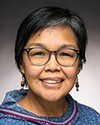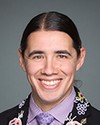Mr. Speaker, kwe kwe. Ullukkut. Tansi.
I am honoured to be speaking today in Canada's Parliament, situated on the traditional lands of the Anishinabe Algonquin people, on an incredibly important bill on behalf of the hon. Minister of Indigenous Services Canada, as her parliamentary secretary.
I represent the people of Fredericton, an unceded Wolastoqiyik territory, the people of the beautiful and bountiful river, as well as my family, my husband and my two children, who are also Wolastoqiyik and status Indians under the Indian Act.
For over a century, Canada passed laws and introduced policy with the express goal of expropriating land using tools that ripped apart families and attempted to destroy culture, language, tradition and identity. The Indian Act essentially reduced first nations identity to status and then used this status to strip away access to what most would consider the bare necessities. Sex-based and other forms of discrimination were used to segregate and assimilate, with the ultimate goal of removing indigenous identity or ending the “Indian problem”.
Today, I am speaking directly to the descendants and elders of those wronged. Despite these repeated and oppressive measures, they persisted. They were resilient. They retained their culture and language. Identity is not a status the government gives, but a way of life and a feeling of love and belonging. It is a way of seeing the world.
It is thus fitting that we rise today to discuss an incredibly important bill that would advance reconciliation and do what is necessary to fix some of what was broken right here in this place through previous pieces of legislation. I am incredibly honoured to have the opportunity to be a part of this process.
To peel back the layers of our colonial history to right the wrongs is exactly why I ran for federal politics. I ran for my kids and their home community of Welamukotuk, a good place to fish. I ran for my students: for Justice, whom I wish Justice a happy birthday, and for Desiree, Brianna, Kitarra, Chrystal, Amber, Bailey and so many more. I ran for my former boss, Bob Atwin, at First Nation Education Initiative. I ran for Billy at Sitansisk and for all Wabanaki nations. Sometimes this place feels very far away from home, but I feel them with me today in this chamber.
We have heard from our partners and we have heard from Canadians. Identity is something that one cannot give or take, but something inherently ours. We are putting the power to determine this identity back in the hands of those who should have always had the power over it. The bill before us today would make important progress by addressing several major inequities in the Indian Act and by responding to long-standing concerns raised directly by first nations about the registration and band membership provisions of the act.
More specifically, this bill proposes to address four key issues. First, it would address the legacy impacts of enfranchisement and help more first nations regain their status. Second, it would return autonomy to registered first nations by allowing them to take their names off the Indian register. Third, it would recognize the rights of all first nations individuals to their natal band membership, ensuring women can maintain critical connections to their home communities. Finally, it would eliminate stigmatizing language about first nations persons with disabilities that is currently part of the Indian Act. If passed, this bill would help return agency to the first nations families that lost their status in this colonial process called enfranchisement.
The minister promised to address these long-standing issues and in December 2022, she introduced this bill and followed through on that promise. The legislators of the past put these harmful policies in place, setting in motion the pain that so many families still feel today, but we are the legislators of a new time, one that reflects an honesty of history and a true commitment to a Canada that lives up to the promises and commitments our predecessors made in treaties and other agreements. Reconciliation is a process. It requires a deep collective commitment to the truth and to action.
Although the Indian Act itself is an inherent problem and partners across this land agree it is a tool of colonialism, many indigenous peoples, leaders and nations see that those approaches to ending this tool of oppression requires steady, honest transfer of control over the delivery of programs and services back to first nations, Inuit and Métis peoples. This proposed legislation is a step in the right direction. It addresses the most foundational element of reconciliation, and that is self-determination.
The people at home might be asking why we are proposing these changes at all, why we cannot just get rid of the Indian Act with its discriminatory title altogether. The Indian Act is archaic, it is paternalistic, it is rooted in racism and Canada must continue to work toward its end. This work is, in fact, a major part of the mandate for the Minister of Indigenous Services.
The last number of years, we have engaged extensively with first nations on the best ways to move away from the Indian Act and protect the rights of people at the same time. We have made significant progress in developing successful alternatives to the Indian Act for first nations in relation to land management. We will continue to work with partners to transfer control and stand up self-determined policies and programs.
In the meantime, thousands of first nations people continue to face discrimination under the Indian Act. The amendments we are proposing in this bill reflect policy first nations have been calling for the federal government to adopt for many years. Past amendments have not addressed these wrongs.
In 2012, through a formal exploratory process, options for reform were studied with first nations and indigenous partners who represent non-status first nations. The study concluded Canada should work with first nations to proactively address the issues with registration and membership under the Indian Act.
In 2018 and 2019, the same themes arose during discussions with more representatives from 200 first nations, who told us that Canada must address these issues and fix inequities in registration and citizenship. What is more, first nations and indigenous partners who represent non-status first nations have told us that addressing the existing issues with the Indian Act must happen before communities can regain full control and jurisdiction over membership, registration and citizenship. In other words, partners told us that passing this bill is a necessary step on our path toward restoring full control of membership and community function to indigenous peoples.
This legislation is not proposed unilaterally by the federal government. The solutions proposed in this legislation represent amendments to the act that indigenous peoples have told us are necessary to move past the act and reclaim their sovereignty from colonial systems.
The first, and most significant, amendment we are proposing to this bill addresses the discrimination caused by a family history of enfranchisement. Members will recall enfranchisement was a policy used with the expressed purpose to eradicate indigenous culture and assimilate first nations people.
Just a few examples will give all Canadians a better idea of how enfranchisement was used to segregate and tear first nations families apart. First nations members lost entitlement to registration and membership in their home communities if they wanted to vote in Canadian elections, own land, serve in the Canadian military, marry a non first nations person or keep their children out of residential schools. This last mention should highlight for all just how painful this legacy has been for some.
For some, enfranchisement was involuntary and happened when first nations achieved professional status like becoming a doctor or a lawyer. For others, it was voluntary, by application, severing talented professionals from their heritage. I use the word “voluntary” reluctantly as this was not a real choice. Imagine having to choose between keeping one's connection to one's community and protecting one's children from residential institutions. It is an impossible decision, but it is one the Government of Canada forced many first nations parents to make.
With these false choices, it is no wonder so many people forfeited their status. I have heard many stories from parents who gave up their status without a second thought to spare their children from the same unthinkable traumas and abuse they faced at residential institutions.
With her permission, I can share the story of Kathryn Fournier, who is here with us today, the stories of her grandfather, Maurice Sanderson, a residential school survivor from Pinaymootang First Nation in Manitoba.
Because of provisions in the Indian Act, he was not able to vote or own property unless he enfranchised, meaning he had to give up his right to Indian Act status. In 1922, Maurice made what Kathryn describes as a “strange and difficult choice”. He applied to enfranchise in order to have the same basic rights as other Canadian citizens. As a result, his wife and children were automatically enfranchised as well. Kathryn put it this way, “He made a very difficult choice that shouldn't have been imposed on him in the first place.”
Kathryn's grandfather's and grandmother's assimilation under the policy of enfranchisement may have provided them with some of the rights of Canadian citizenship, but today, generations later, the ripple effects of that policy continue to have negative impacts. The way historic policy erased connection to ancestry and culture continues to be felt. The process of enfranchisement was a deliberate effort by the federal government to colonize and to decrease the numbers of indigenous people who had rights.
Following a pattern of coercion and deception, this proposed legislation continues on Canada's journey to address and amend those decisions of the past that have hurt so many families. Over the last few decades, the government has been trying to reverse these policies by restoring status to first nations who lost it.
In 1985, the government acknowledged enfranchisement was a discriminatory policy, and it was removed from the Indian Act with the introduction of Bill C-31, an act to amend the Indian Act. At this point, people who had been enfranchised could reclaim their status.
The inequity we seek to remedy today is the inability for those with a family history of enfranchisement to transmit status to descendants in the same way that those without an history of enfranchisement are able to.
I ask the hon. members here today: should the family members and descendants of these people continue to be penalized? It is clear that enfranchisement is discriminatory and we need to eliminate all of its residual impacts. To do so, it is proposed that section 6(1)(d) and 6(1)(e) of the Indian Act be repealed.
Individuals currently registered under these categories will have their registration category amended to a 6(1)(a.1) if they were the individual who was enfranchised and (a.3) if they were the child or descendant of the individual who was enfranchised.
The amendment on enfranchisement addresses the concerns brought forward by the Nicholas civil action lawsuit and it will fulfill the recommendations on this issue heard during previous broad engagements. I am proud to acknowledge that Ms. Mary Sandra Lovelace Nicholas is Wolastoqiyik from Tobique (Neqotkuk) First Nation. We are grateful for her courage and trail-blazing as a fellow New Brunswicker.
The second inequity addressed by Bill C-38 concerns the ability for individuals to remove their names from the Indian register. The Indian register is the official record of people registered under the Indian Act in Canada. It is maintained and managed by the Indian registrar, part of Indigenous Services Canada, and exists to determine who is registered under the act and entitled to programs and funding across federal and provincial governments, for example, on-reserve housing, non-insured health benefits, education or tax exemptions.
However, there is a major gap in the authorities of the registrar. While they can add names to the Indian register, they have no formal legal authority to remove the names of registered individuals even when the individuals request deregistration. This is an issue that first nations have called on Canada to address and today, with this, we are doing just that.
For some, deregistration is a matter of having control over their own identity. For others, it is a barrier to gaining membership to other indigenous groups. This has prevented a number of people from accessing important services and benefits through a group they wish to identify with that they should be entitled to.
To fix this issue, this legislation will provide individuals with the right and ability to have their names removed from the Indian register.
That said, individuals who deregister will still be eligible to re-register and their decision to deregister will have no impact on their or their descendants' entitlement under the Indian Act.
This means that the children of deregistered individuals would still be entitled to status. It can only be done at the request of the individuals and protections will be made to ensure that it is not used with mal-intent.
In the spirit of reconciliation, the implementation of this amendment will be co-developed with indigenous partners, to ensure that the needs of all impacted groups are well served.
Bill C-38 also addresses a sex-based inequity related to band membership provisions. Bill S-3 received royal assent in 2017 and eliminated known sex-based inequities in the registration provisions of the Indian Act.
Because of the limited scope of that mandate, however, we were not able to address these sex-based inequities in band membership. This inequity arises from the fact that, until 1985, first nations women who married first nations men from a different nation were automatically transferred to their husband's band list.
While these women did not lose their entitlement to registration, they did lose connection to and membership in their natal band, along with any associated treaty rights, benefits, settlements and services. These women were automatically disconnected from their home communities even if they may have wanted to restore their social and cultural connection to their natal band.
The bill we are proposing today will amend the Indian Act to allow first nations women to seek re-affiliation and membership with their natal bands. This is significant. Supporting and empowering indigenous women is key to supporting indigenous communities, tradition, language and culture as a whole.
The final amendment in Bill C-38 addresses some outdated and offensive language that still remains in the Indian Act today. The act refers to “mentally incompetent Indian”. It is obvious that this term is outdated, offensive and stigmatizing.
Bill C-38 would replace this term with the updated term “dependent person”. This amendment is a logical step forward and would align the Indian Act with developments in capacity and guardianship law over the last 50 years.
In summary, amendments proposed in this legislation would fix four long-standing issues in registration and membership under the Indian Act relating to enfranchisement, individual deregistration, natal band membership and some outdated and offensive language in the Indian Act.
If all enfranchisement issues are addressed, approximately 3,500 people could be newly eligible for registration with these amendments.
These proposed changes represent significant and meaningful action to the affected people and their families. They also demonstrate to indigenous peoples a steady and forward movement by Canada to make amends to the many ways colonial laws and actions intentionally harmed them and their communities.
Even with these proposed changes, there is still much more work to do. Ahead of us, we have the work of undoing the racist policies reflected in the Indian Act, including those related to the second-generation cut-off.
We are engaging with partners so we can continue to explore how to move forward on this deeply personal issue. Indigenous identity must be determined by indigenous individuals, full stop. It is our responsibility to proactively right historic wrongs and make the changes asked of us by first nations and indigenous partners who represent non-status first nations. This bill would right some of those wrongs.
It is in this way, working together in good faith, that we would advance reconciliation and support a renewed relationship between Canada and first nations, one not marred by the paternalism and control of the Indian Act, but one based on rights, respect, co-operation and true partnership. Woliwon.












